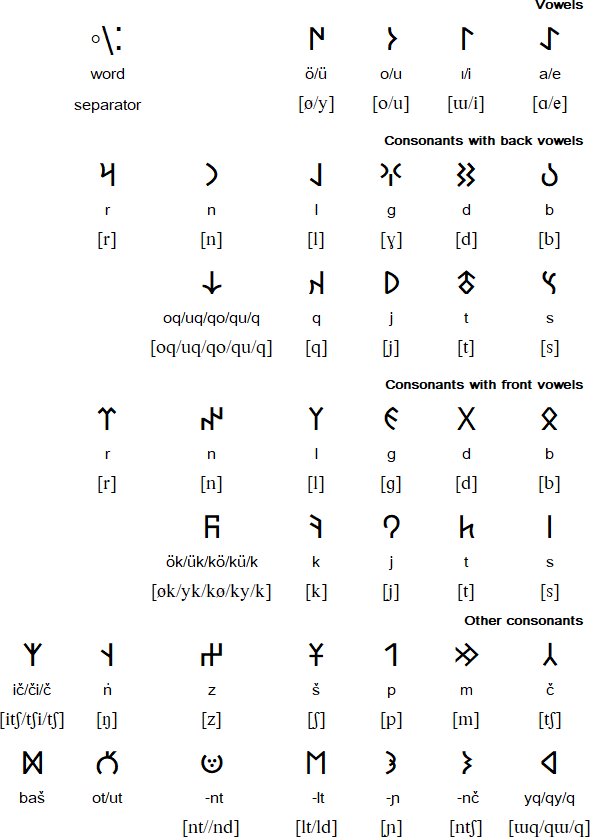Because of a superficial resemblance to the Runic alphabet, the alphabet is also known as Orkhon or Turkic runes. This resemblance is probably a result of the writing materials used - most inscriptions are in hard surfaces, such as stone or wood, and curved lines are difficult to inscribe in such surfaces.
The Orkhon alphabet is thought to have been derived from or inspired by a non-cursive version of the Sogdian script. By the 9th century AD, the Orkhon and Yenisei alphabets were replaced by the Uighur alphabet, which developed from the cursive version of the Sogdian script.
Notable features
- Type of writing system: alphabet
- Direction of writing: written mainly from right to left in horizontal lines, though some inscriptions are written vertically with the letters rotated by 90°. When written vertically, it read from bottom to top and right to left.
- Some consonants have two forms, one of which was used with front vowels, the other with back vowels.
- Used to write: Old Turkic (a.k.a. East Old Turkic, Orkhon Turkic, Old Uyghur), the earliest attested form of Turkic, found in Göktürk and Old Uyghur inscriptions dating from between the 7th and 13th century.
Orkhon/Old Turkic alphabet

Sample text

Transliteration
Türk Oguz begleri, bodun, eşidin üze Tengri basmasar asra yir telinmeser Türk bodun ilinin, törüngün kim artatı udaçı erti?A recording of this text by Görkem
Modern Turkish version
Türk Oğuz beyleri, kavmi, işitin; üstte gök (Tanrı) bastırmasa, altta yer delinmese Türk kavmi; ilini, töreni kim bozabilirdi?English version
Türk Oguz chieftains, clans, listen; unless the sky (Sky is also God) crushes, the ground punctures Turk clans; who could ever destroy your land and law?Links
Information about the Orkhon alphabet and Old Turkic languagehttp://en.wikipedia.org/wiki/Old_Turkic_script
http://gokbeyuluc.wordpress.com
http://fankibiber.wordpress.com/
http://kokturukce.blogspot.com/2008/09/gktrk-yazlarnn-harflerinin-kkeni-4.html
http://www.gokturkce.net
http://irq.kaznpu.kz/?lang=e&mod=1
Details of ancient Turkic languages and alphabets (in English and Russian)
http://www.turkicworld.org
Orkhon font
http://m10lmac.blogspot.com/2010/03/typing-orkhonold-turkic.html
Speculations on connections between Turkic runes and other runic alphabets
http://www.antalya-ws.com/futhark/FUTHP2E.HTM
No comments:
Post a Comment
Note: Only a member of this blog may post a comment.